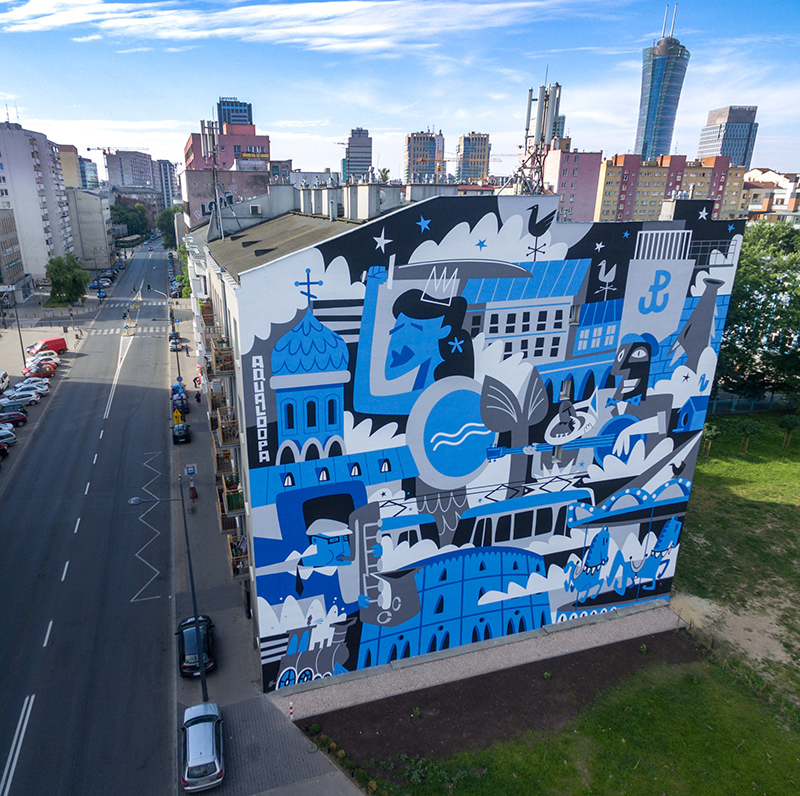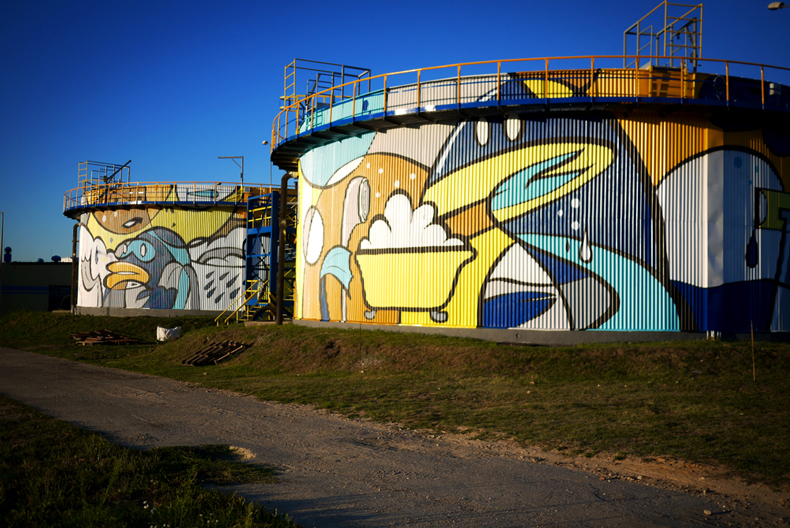I’m a matador of fluid lines and shapes, a lucky man who lives on his passions, and a hunter of imaginary beings… When I was a teenager, I took up playing the congas and bongos. I have played in various bands and, as time went by, I turned it into my job. I am interested in Cuban music. It influenced my art and style a lot.
Artist and percussionist Igor Aqualoopa talks about the intersections between his art and music, which informs and invigorates his work.

Facebook Warsaw
How did your tryst with art begin and what inspired you?
Ever since I was a kid, I’ve been fascinated by cartoons and animations that were aired on Cartoon Network like The Powerpuff Girls, Cow and Chicken, Samurai Jack and Dexter’s Laboratory. It was the world of my aesthetics. I have also been interested in the works of Pablo Picasso and the Japanese arts like calligraphy and ink wash painting.
When I was a teenager, I took up playing the congas and bongos. I have played in various bands and, as time went by, I turned it into my job. I am interested in Cuban music. It influenced my art and style a lot. My visual creations are strongly inspired by the colours, the rhythm, the vibe of the concerts and CDs, and all the emotions that I experience on stage, in studios and in rehearsal rooms.
I have always liked to doodle, cover the sheet with figures and characters in strange worlds. Graffiti and street art took it to the next level. I think that walls, as a medium, freed my creative potential. I love large surfaces of walls in cities and rooms simply because their spaces are not limited by a sheet or a canvas.
It is significant that all my creative activities have often taken place on stage, among spectators. Privately, I am rather introverted, while the art I make is definitely extroverted, colourful, ‘dancey’ and flashy.

Tell us a little about your practice and process?
I’m an illustrator, animator, street artist, and painter. I’m a matador of fluid lines and shapes, a lucky man who lives on his passions, and a hunter of imaginary beings.
My inspirations come from a variety of sources, such as cartoon animations, urban art and the art of Picasso. I am interested in motion graphic and street art activities. I am a member of the Polish Digital Graphics Group, a musician and the co-founder of Warsaw Afrobeat Orchestra.
My visual language is composed of vibrant colours and fluid shapes combined with urban aesthetics. So far I’ve had several individual exhibitions in Poland.

What kind of materials do you work with? Shed some light on your technique.
I use both traditional and digital techniques. I often combine them. I transfer my sketches from paper to the computer, where I process them digitally. Sometimes, I go the other way around and transfer my works from the computer to paper or canvas, in order to give them a manual, organic character.
I use acrylic paints and sprays for paintings and walls, but I also love ink and brushes. I often sketch with a pencil or a pen. When it comes to digital techniques, I like vectors that I make in Adobe Illustrator. Sometimes, I add a bit of a manual look to them by using Photoshop brushes. When I make animations, I work mainly on digital platforms.

Any projects which were especially memorable for you?
My notable projects have included designs for Levi’s, Facebook, Absolut Vodka and Greenpeace. I work closely with a number of local brands, producing covers and posters. I have collaborated with various studios from foreign countries, including Brazil, South Korea, Canada and the United States.

Could you talk about your work vis-a-vis you and the people involved with the project?
In my work I like to reach into the unconscious. I trust it and let myself go with the flow. I seldom have an idea when I sit down to work and for me this is the best start while engaging in creation of art. I begin to doodle and after a while some interesting shapes appear. This is the hatch phase. What comes next is the laborious work, putting the material in order, redrawing, etc.
When I work on graphics for large surfaces, I do it either spontaneously, directly on the wall, or I sketch them with a pencil on paper, and then refine the form on the computer to make it ready to be transposed on to the wall.
People who ask me to do my art on their walls often want to see a project before I paint. Luckily, not everyone wants to control my creative process. In my opinion, the walls that were painted spontaneously, because someone had trusted me and given me a free hand, are much more lively and vivid.

How do people react to your work? How do you challenge a viewer’s perspective?
The way people perceive my work is of great interest to me. I am often surprised by the areas or parts they want to explore. A clothing line that had used my designs enjoys much popularity. It is important for me that my art is easily approachable, even though sometimes it can be difficult to figure out what my pictures show. The viewers are often inspired by ambiguities and omissions. The lines and shapes melt in my works; the characters fuse together and become someone new. This provokes some kind of creative anxiety in the viewers and doesn’t allow them to get used to the paintings. In Gestalt psychology, such incompletion of experience is called unclosed gestalt. By leaving my shapes and forms unclosed, I provide the viewers with the vivacity of perception.
My viewers are mostly young people. Some of them focus on the details or characters, while others are fascinated by the patterns that can be found in each composition. What moves them in my works is the fusion between pop culture aesthetics and art.

What are you doing presently?
Currently, I run my own animation and illustration practice in my hometown, Warsaw. I focus on corporate illustration, wall design and clothes prints.












Add Comment